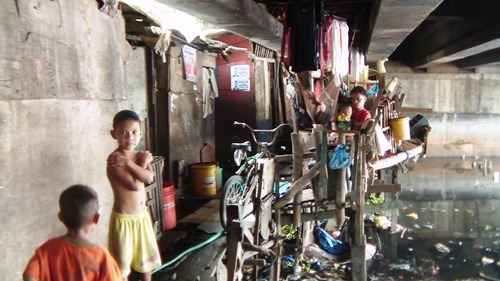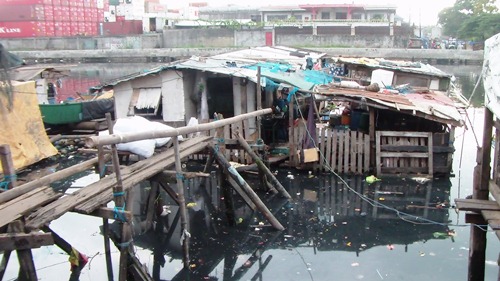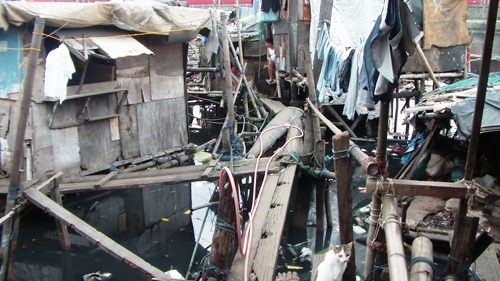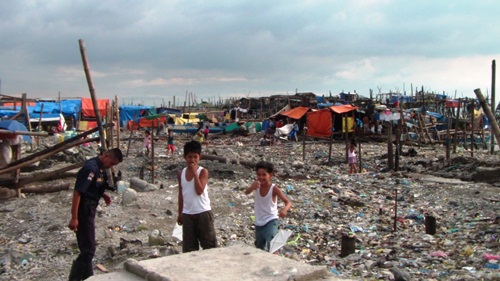"Bat people" and "floating houses": hope in the lowliest of Manila's slums
In this final of three articles, Marcus Tudehope finds hope and civic pride in the most forgotten slums of the Manila region, and calls for planners and advocates to recognise the compatibility of their goals and shift the paradigm of planning in Quezon City.
Partido Lakas Ng Masa (Party of the Laboring Masses) are a recently formed Socialist movement pursuing seats in the Philippines National Congress. At a chance meeting, a spokesperson told me that if I wanted to see the true face of the economy in Manila, it wasn't in the famous Makati business district, it was the slum in Navotas.
I'd heard of Navotas as home of the "bat people", so called because they build their shanties up under a traffic bridge in the dark. I arranged to go there with Greg, another socialist and writer who makes pamphlets about the constitution and international human rights legislation and distributes them among the urban poor.

Under the bridge at Navotas: the luckier sections that receive some sunlight
I know it's not a competition, but there are people in Navotas living in markedly the worst conditions I've seen so far. These structures are among the most derelict and built on a base of foul-smelling stagnant water choked with litter and refuse. For the people further under the bridge, there is no opportunity to bootleg electricity, almost no ventilation or light penetrating into the dim, claustrophobic, candlelit spaces.

Some of the younger generation of "bat people"
We are met by the president of a local community group, a senior resident who is very articulate and gives us a guided walk. In the dingy space under the bridge we meet a bubbly young girl who tells me she's 17 and has been living here since she was born. She invites me inside her home and I accept, leaving my shoes on a wet bottom floor that I can see floods when the tide comes in. In a dark, stuffy interior that couldn't be more than 9m² she tells me she shares this space with the four other members of her family, but they have a "second floor". To get up, I contort myself around a homemade ladder and into a loft with a ceiling height that makes it impossible to sit upright. It feels about ten degrees hotter in here than outside; all that's visible is a single statue of the Virgin Mary in a pool of candlelight in the corner. She taps on the ceiling, which turns out to be the metal underside of the traffic bridge. A dull rumble gets more and more intense until the floor and walls begin to vibrate with it; she tells me that's just a truck passing overhead.

A "floating house" in Navotas
Navotas is also known for the "floating houses" where residents build shanty house boats that sit in the brackish water about 15 metres offshore. I learn that a major source of income here is scavenging metal from the waters in Manila Bay to be sold at junk shops. Local men and boys have become adept at skin diving to bring up anything of value from the sea floor. Recently two men died after they brought up an unexploded shell from the wreck of a Japanese WW2 battleship, which exploded when they took a hacksaw to it.

The precarious walkways linking the houses to the shore
The houses are reached by an unbelievably precarious network of salvaged wood and garbage nailed together like the handiwork of the Lost Boys. As we walk the whole structure flexes and submerges a little. These walkways and houses have stopped any natural circulation in this part of the water, so everywhere are built up litter and pond scum making it the last thing you'd want to fall into. (Later as we sat a small child did fall in, causing half a dozen people to scramble instantly to fish her out.)

Ocean views
The nearby Navotas beach is the site of another slum where a fire recently rendered approximately 500 people homeless. The opportunistic land owner took advantage of the situation and hired a private security force to try to prevent residents from rebuilding. The Barangay (neighbourhood government) has since been using the local gymnasium as a temporary shelter for the homeless, who at the time of my visit had been living there for four months.

Children unfazed by a security guard
We visit the site of the fire and it's a hive of activity. The bones of the shanties that were once destroyed are visible as a forest of bamboo sticking out of the rubble and sand. The contested space sits barren in the centre while in every direction are signs of people rebuilding and repairing their homes. There are children playing in between security guards with shotguns posted throughout.

Guards armed with shotguns resist any reconstruction in the contested space
I was initially warned against going inside the gymnasium where the victims of the fire were staying, so my guide Greg and I arranged a steadfast escort of four prominent Navotas women to accompany us. The gym is dark and the interior is audible before it is visible — the noise of several hundred children playing with abandon. The building is like a high school hall with concrete tiered seating. Families have claimed 2m² sections to sleep and small piles of belongings demarcate one family's patch of floor from another's. Families also spread up the concrete steps so that every bit of flat space in the gym is occupied and clothes hang off the exposed metal rafters. The view is a sad one.

The interior of the gymnasium hosting the homeless
The President of another community group tells me that these people have been given two options by the Barangay: go back to the province "where they came from", or accept a one-off payment of 1500 pesos (34 US dollars) and rent a house in the area. He explains that he has five children and is supporting his wife's mother solely on his income from driving a motor tricycle in Manila. Neither option is an option for him. He tells me that the gym where they've been for four months has a problem with the spread of disease among children and there is only one toilet for the whole complex, but he needs to stay where he can earn an income so has no choice but to remain.
On the day of my visit the people had been issued with a deadline of the previous Monday to vacate, and told that if they didn't they would be removed by force. As seems often to be the case, no authorities showed up at the nominated time. Now the people live in uncertainty every day as to when and how an eviction might take place, talking in hushed tones about how they will bar the doors or defend themselves when the time comes. Our host asks me what I would do in his situation and I'm totally lost for words. The government has shown that it wants these people out of sight and mind, and has few qualms about using force to achieve that.
It's heart wrenching to see all these people seemingly left with no option but to start a fight they have no wish to be in and will inevitably lose. I feel utterly inadequate when he looks at me with what looks like genuine hope and asks for my help. The generic condolences I offer in return sound totally hollow to me but he thanks me nonetheless.
Hoping for new partnerships
As a whole, Quezon City abounds in contradictions. Decadence and squalor, privilege and exclusion, and people able to find happiness amidst utterly miserable circumstances underpin a unique metropolis. How to avoid conflict when the basic rights and needs of the poor appear contradictory to projects like the Quezon City CBD is the daunting task now confronting planners. On one level, it seems planners find it all too easy to focus on the ends rather than the means, on the citywide benefits rather than the dehumanising toll exacted on places like Navotas and San Roque. At the same time, it is too easy to come from a first-world context and impart judgement on the decision makers who must deal with these issues on a daily basis.
Appeals for a more inclusive development process on purely humanitarian grounds are totally necessary and admirable. However my time here leaves me with the impression that they are not enough. Perhaps what is being sought by either side of this contested space is not as mutually exclusive as appearances suggest. The image of a metropolis as a stable, efficient, aesthetically impressive cultural hub is clearly desirable to attract capital, tourism, invesment and bring improvements to Quezon City. The overzealous pursuit of that image by trying to engineer a sanitised, homogenous space at the expense of existing communities is visibly counterproductive. In the long term such removal of urban density will sever any beneficial linkages between the formal and the informal economy, increase social polarisation and fuel the antagonism between different groups. Levels of crime and violence are likely to increase, creating further instability and overall a less attractive location to live, visit or invest in.
From any angle, the inescapable reality is that displacing or repressing people will not make them disappear. If they have no other options to secure a livelihood they will return, all the more desperate than they were before. If exclusion and repression are the cause of that desperation then meeting it with more of the same will only serve to perpetuate a conflict.
Conscious, then, of the difficulties of both sides, could we perhaps work towards reconciling the ideal of the stable, investment-friendly city with the presence of the urban poor? Improving living standards and removing the supreme anxiety of insecurity of tenure would go far to easing tensions and allowing the strength of community and civic pride I saw surviving in the most unlikely circumstances to flourish, for everyone's benefit. Could new partnerships between planners, advocates and the communities themselves yield innovative ways to create a safe, efficient cultural hub that preserves and utilises this kind of diversity as an asset, rather than seeks to eradicate it? There are clearly no simple answers or quick fixes to satisfy all parties. However the appalling sights and stories from inside Navotas, Payatas and San Roque make it abundantly clear that business as usual simply cannot be allowed to continue. Nothing less than a paradigm shift is needed for the sustainable development of Manila.

